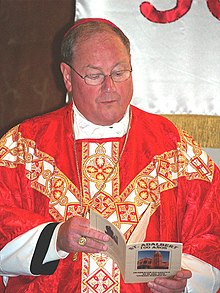 I came across a beautiful icon of the Transfiguration last week as I was preparing a retreat for the seminarians in Singapore. In Orthodox iconography, although the figures and art form seem overly two dimensional, we have no static scene, but what we have is drama and a moment full of movement. Icons serve as narratives to open our eyes and hearts to a different realm of the Hidden mystery of God. Just the like icons on your computer screen which act as inter-phase portals linking you to another programme or application, these Christian art pieces, and perhaps more than that, links the visible world of the believer to the world of the invisible.
I came across a beautiful icon of the Transfiguration last week as I was preparing a retreat for the seminarians in Singapore. In Orthodox iconography, although the figures and art form seem overly two dimensional, we have no static scene, but what we have is drama and a moment full of movement. Icons serve as narratives to open our eyes and hearts to a different realm of the Hidden mystery of God. Just the like icons on your computer screen which act as inter-phase portals linking you to another programme or application, these Christian art pieces, and perhaps more than that, links the visible world of the believer to the world of the invisible. If depicting a scene from scripture, it tells a story that goes beyond the literal sense of the gospel text: here are live, happening events, real human beings, and challenges to the past, present and future. The icon of the Transfiguration which I came across was so rich with intricate details, each with a story to tell, and perhaps layers upon layers of meaning, that I found myself looking at it for almost an hour.
But what struck me most at first glance were the odd shapes that seemed to be protruding from the back of Jesus as if he had a pair of rectangular shaped wings set at strange angles. The circle of light (or mandorla) that surrounded the figure of glorified Jesus was obvious. It not only denoted the radiant light of his transfiguration but also represented the inner uncreated light emanating from Jesus, the Word of God, which pointed to his divinity. But was there a need to add these two other odd shapes vectors? They didn’t appear to be rays of light or at least stylized versions of it.
Upon further research, I discovered that these two odd shaped vectors represented the two fold movement of ascent and descent. On the one hand, it symbolized the ascent of Jesus and this three disciples up the mount of transfiguration and subsequently their descent thereafter. On a second level, it spoke of the two fold movement of faith. The first movement of faith or light of faith is a prophetic light which reveals the true identity of Jesus – apart from his messianic identity, Jesus is also the Only Begotten and Beloved Son of the Father. A second movement of faith or the light which illuminates and enlightens the disciples and all of us and help us make an assent of faith to what has been revealed.
Both these meanings may seem distant and abstract. But today, I would like to share with you what the ascending and descending movements of the Transfiguration say to us about a subject that is very close to us, something which we experience frequently, but perhaps with very little understanding. The two movements of the Transfiguration speaks to us of the two fold movement found in our liturgy, that is whenever we celebrate the Mass or any of the other Sacraments. The word “liturgy,” comes from the Greek word ‘leiturgia’ which means ‘public works.’ In ancient Greece, rich people often made expensive contributions to the city or to the state in terms of financing public works and received honour and privileges in return. Thus, the two fold movement could also be discerned from this profane use of the word liturgy – ‘you give and you receive in return.’
In the case of Christian worship, the celebration of the Sacraments, carries a similar two fold meaning. But here, the direction is reversed – ‘we receive in order that we may give.’ For us the word liturgy means the work of God in a dual relationship: the work God does for us and the work done unto God. Thus, liturgy is both what God does and what we do in return. Traditionally, the descending movement of God has been called ‘sanctification’ whereas the ascending movement of man has been called ‘glorification.’ God sanctifies man so that man may glorify God. This is what liturgy is all about!
The Transfiguration occurred not so much for the sake of the Lord as for the sake of His disciples. In the story of the Transfiguration, the glory of the Son is revealed in both the change of his appearance as well as the words of the Father descending from the clouds – “This is my Son, the Beloved, Listen to Him!” This is the descending movement of God. By revealing the divine nature of his Son, God was not merely providing the three apostles with a glimpse into the inner life of the Trinity but also providing them with the prototype of their own sanctification, or as the Eastern Christians put it, their deification. The Greek word for Transfiguration, ‘metamorphosis’, does not only indicate a transformation in appearance but also a progression or change of being from one state to another that will reveal one’s inner beauty. The disciples were shown what man could really be. They should not be content with just being caterpillars or trapped in the chrysalis of their earthly existence. They are destined to become beautiful butterflies that manifest the divine glory of God. In response to this revelation, Peter offers to build the three tents or shelters. At one level, these were mere dwellings to prolong the experience. At a deeper level and taking the spiritual sense of the text, Peter was actually offering to build a shrine, a temple or a sanctuary to glorify that which he now beholds – the visible Christ who reveals the invisible face of God.
This two-fold movement in fact unfolds in a Trinitarian and Ecclesial shape in our Eucharist; that is, God the Father comes through his Son to the Church for the sake of the world, and the Spirit illumines and vivifies every dimension of this movement. In the other direction, the Church, speaking in the name of the whole world, responds in thanksgiving by offering to the Father the very gift she has received: the Son. The Spirit effects the transformation or more exactly transubstantiation of the Church’s gifts into the Body and Blood of the Son.
In the Liturgy of the Word this twofold movement is also enacted by means of speech. God speaks, and we speak back. We can say that God speaks through his Son in the Holy Spirit to the Church; and the Church responds. Jesus Christ stands exactly in the middle position of these two directions of movement, and thus he is named Mediator. What God says to the world is his Son, Jesus Christ. What the world says back to God is also Christ, the Word made flesh, joined to the Church. The Church also plays the role of mediator here. God speaks to the world in speaking to the Church. The Church speaks for the world in responding to God.
Thus, the Transfiguration was not merely a historical event that prepared the disciples to face the trials ahead of them, especially that of losing their Master and Lord to the horrible fate of the crucifixion. The Transfiguration is re-presented and replayed throughout the centuries in the celebration of our liturgy. Here too we witness the transfiguration of the Lord as the bread and wine are changed into his Body and Blood. But it is not only the species that are changed; we too are ‘metamorphosised.’ At every mass, whether we are aware of it or not, we are sanctified and deified, we are transformed from glory to glory into the image of our Archetype, the new Adam, Christ our Lord, so that we may render worthy praise and glory to God. In the Transfiguration, Christ speaks to us of the fact that the world must be transfigured by love, which none of us has within himself, but which He is offering to us. In the Transfiguration, we are given the certain cause and foundation of our hope in order to follow Him on the way of the cross. Through the Transfiguration, the Church reminds us that present suffering is incommensurate with eternal glory, and that our brief and light suffering produces eternal glory in abundance. The butterfly will emerge from its chrysalis.





 Of course, their service was impeccable and we enjoyed the buffet and rolled off to shop after...
Of course, their service was impeccable and we enjoyed the buffet and rolled off to shop after...

















